Archive for October, 2018
Rock-and-roll scholar analyzes Beatles’ White Album as psychedelic music
Monday, October 22nd, 2018To mark the 50th anniversary of what is widely known as the White Album, an English literary and rock-and-roll scholar at The University of Toledo argues the 30-song double album released in November 1968 titled “The Beatles” coherently showcases the fruits of shared psychedelic experiences between Paul McCartney, John Lennon, George Harrison and Ringo Starr.
Dr. Russell Reising, professor in the UT Department of English Language and Literature and original member of the Rock and Roll Hall of Fame and Museum’s Educational Advisory Board, wrote a 22-page lyrical analysis “Where Everything Flows” to be published next year in a collection of essays about the record.
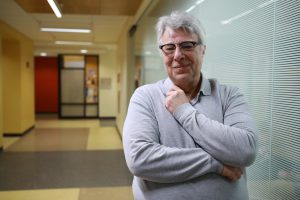
Dr. Russell Reising, professor in the UT Department of English Language and Literature
“Tense, yes. Clashing, yes. Disconcerting, yes. Incoherent and lacking any kind of unity, no. ‘The Beatles’ is that place we can go, where everything flows. And flow it does through the broadest possible range of musical styles, lyrical evocations and emotional extremes,” said Reising, who has published books about the Beatles’ “Revolver” album and Pink Floyd’s “Dark Side of the Moon.”
Through the unique, unprecedented scope of diverse subject matter and varied songs like “Ob-La-Di Ob-La-Da,” “Helter Skelter,” “While My Guitar Gently Weeps,” “Back in the U.S.S.R.,” “Happiness is a Warm Gun,” “Blackbird,” “Rocky Raccoon” and “Revolution 9,” Reising said the album reveals the transformations of the Beatles’ philosophical point of view and psychological insights after undergoing LSD experiences resulting in psychedelic music.
“They are an expression of the communal consciousness of The Beatles at the time when they stop taking LSD, and the influence of their experiences starts to make itself felt in songs that might not necessarily sound at all psychedelic,” Reising said.
“The diversity of the album is like an attempt to reproduce in record form the philosophical commitment to integration, unity and incorporation – as opposed to conflict – that comes about as a result of the long, reflective, introspective final phases of an LSD experience that influence how one thinks and lives their lives. It makes them more compassionate and more open to a wider range of experiences.”
The book titled “The Beatles through a Glass Onion: Reconsidering the White Album,” which is expected to be released in March 2019 from the University of Michigan Press, will be the first scholarly volume devoted to the album’s legacy in the Fab Four’s career and in rock history.
“The White Album is awfully, awfully good,” Reising said. “This is not one of my favorite albums, but I like it more than a lot of people do.”
“Even after 50 years, the critics’ view of the White Album remains contested,” said Dr. Mark Osteen, professor of English and director of the Center for the Humanities at Loyola University Maryland, who edited the book. “Given the disparity in response ranging from ‘the product of a band in disarray’ to ‘a rich tapestry of musical textures,’ we believe that this landmark record — still one of the top-selling rock albums of all time — deserves reconsideration.”
Reising’s essay fits into the book’s first section, which outlines the personal, musical and political contexts for the album. The other chapters focus on the music, musicians, lyrics and the album’s legacy.
The songs travel time and space all over the globe. They feature animals such as McCartney’s dog in “Martha My Dear,” as well as different kinds of people like Chairman Mao, Bungalow Bill and the dentist who will pull Eric Clapton’s teeth. The songs have musical and sonic effects from Western and Eastern traditions, reverse tapes, dainty piano pieces and religious songs.
“No two songs are the same,” Reising said. “You have everything from musical simplicity to incredible complexity. It’s offering the broadest possible range of ideas, attitudes, emotions and sounds that a day in the life might contain.”
Reising evoked James Joyce’s “Ulysses” and Herman Melville’s “Moby Dick” in his commentary on the Fab Four’s songs written between meditative sessions in India in a quest to find inner peace.
“It is commonplace among Melville scholars to refer to the Pequod in ‘Moby Dick’ as a microcosm of the entire world,” Reising said. “We can see ‘The Beatles’ in similar terms.”
“’The Beatles’ might not exactly be an album whose songs encompass the interconnectedness of all things, but the range of musical styles, of vision, even of length represent something that no other album has even remotely approached, something akin to what James Joyce attempts in ‘Ulysses’ or ‘Finnegan’s Wake.’”
The band became open in the White Album to inviting other significant contributors to their musical efforts.
“They deploy a significant number of ‘partners’ in an unprecedented way,” Reising said. “Either the wife or girlfriend of each Beatle performs on at least one song: Patty Boyd on ‘Piggies,’ Maureen Starkey on ‘The Continuing Story of Bungalow Bill,’ Francie Schwartz on ‘Revolution 1,’ and Yoko Ono on ‘Birthday.’ Never before had wives or girlfriends been present in the recording studio.”
Other artists, including Clapton, Jackie Lomax and Nicky Hopkins, were included.
“Never before had any such independent or otherwise group-affiliated musicians graced Beatles recordings,” Reising said.
He said the album is almost like a day in the life, from sleeplessness to insomnia to gentle easing to sleep. The first song, which starts with screaming jet engines, has a lyric, “Didn’t get to bed last night;” the album has a middle song titled “I’m So Tired;” and the last song is called “Good Night,” ending the album with Starr singing, “Good night, sleep tight,” and then whispering, “Good night… Good night, everybody… Everybody, everywhere… Good night.”
The 50th anniversary of “The Beatles” is Nov. 22.
UT research finds link between refined dietary fiber, gut bacteria and liver cancer
Thursday, October 18th, 2018Many of the processed foods we find on grocery store shelves have been loaded up with highly refined soluble fibers such as inulin, a popular probiotic that recently received approval from the Food and Drug Administration to be marketed as health-promoting.
But a new study from The University of Toledo’s College of Medicine and Life Sciences is raising serious questions about whether the risks of adding refined fiber to processed foods may significantly outweigh the benefits.
Dr. Matam Vijay-Kumar, director of the UT Microbiome Consortium and associate professor in the UT Department of Physiology and Pharmacology, and his research team recently investigated if a diet enriched with refined inulin might help combat obesity-associated complications in mice.
While the inulin-containing diet did stave off obesity in 40 percent of mice, many of those same mice went on to develop liver cancer at the end of the six-month study.
“The findings shook us,” Vijay-Kumar said, “but at the same time we recognized their potential importance and accepted the challenge of exploring how processed dietary soluble fiber was inducing liver cancer.”
Although this study was performed in mice, it has potential implications for human health. It also suggests, researchers say, that enriching processed foods with refined, fermentable fiber should be approached with great caution.
“We fully appreciate that the fibers present in whole foods like fruits and vegetables are healthy,” Vijay-Kumar said. “Because of that, fortifying or adding purified fiber to processed food sounds logical. However, our results suggest it may in fact be dangerous.”
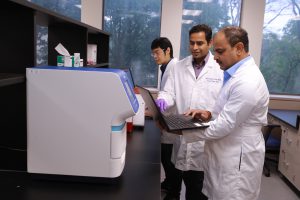
Dr. Vishal Singh, center, a Crohn’s and Colitis Foundation Fellow at The University of Toledo, recently authored a study published in the journal Cell that found a link between highly refined soluble fibers and liver cancer. He is pictured with fellow researchers Beng San Yeoh, left, a PhD student, and Dr. Matam Vijay-Kumar, right, director of the UT Microbiome Consortium and associate professor in the UT Department of Physiology and Pharmacology.
The findings were published in the Oct. 18 issue of Cell, one of the world’s leading biological journals.
There are two basic types of naturally occurring dietary fiber, soluble and insoluble. Soluble fibers are fermented by gut bacteria into short-chain fatty acids. Insoluble fibers pass through the digestive system unchanged.
While both types are beneficial, the concern raised in the study relates to how gut bacteria break down the highly refined fiber that is added to some processed foods as a dietary supplement.
Dr. Vishal Singh, a Crohn’s and Colitis Foundation Fellow at The University of Toledo and lead author of the paper, said refined fiber is a new addition to our diets and that we are in the very early stages of understanding the risks and benefits it may present.
“Soluble fibers added to processed foods are not part of a natural meal,” Singh said. “The inulin used in this study is from chicory root, which is not a food we would normally eat. In addition, during the extraction and processing of the fiber, it goes through a chemical process. We don’t know how the body responds to these processed fibers.”
Chicory root is used as a source of inulin to fortify fiber in processed foods.
The mice that developed liver cancer in this study had altered and elevated gut bacteria, a condition known as dysbiosis. Intriguingly, the researchers observed no evidence of liver cancer in inulin-fed mice that were treated with broad-spectrum antibiotics to deplete gut bacteria.
The UT researchers collaborated with researchers at Georgia State University who performed a similar study in germ-free mice that completely lack gut bacteria. The absence of liver cancer in those mice further confirmed the contributory role of gut bacteria.
The bacteria collectively known as gut microbiota degrade and digest soluble fibers via fermentation. To inhibit that fermentation process, the UT researchers fed mice beta acids derived from Humulus lupulus — a plant more commonly known for producing the hops that go into beer to prevent spoilage from fermentation.
“Strikingly, feeding beta-acids to inulin-fed mice averted liver cancer, which further reinforces our hypothesis that gut bacterial dysmetabolism primarily driving liver cancer in these mice,” Singh said.
Researchers also found they could halt the development of liver cancer by intervening to replace inulin with the insoluble fiber cellulose.
“Cellulose could not be fermented by gut bacteria present in mice or humans. This finding again highlights the link between bacterial fermentation of soluble fiber and liver cancer development in these mice,” said Beng San Yeoh, a graduate student in Vijay-Kumar’s lab and another lead author of the study.
Researchers say their findings suggest the need for more studies that look at human consumption of the type of refined fiber found in processed foods.
“Our study is going against the conventional wisdom of what people think, that fiber is good, no matter how they get it,” Vijay-Kumar said. “We do not want to promote that fiber is bad. Rather, we highlight that fortifying processed foods with refined soluble fiber may not be safe or advisable to certain individuals with gut bacterial overgrowth or dysbiosis, whose abnormal fermentation of this fiber could increase the susceptibly to liver cancer.”
The study was supported by the National Cancer Institute of the National Institutes of Health.
Eleanor N. Dana Cancer Center to offer free breast cancer screenings, panel discussion on latest precision medicine treatments
Wednesday, October 17th, 2018The Eleanor N. Dana Cancer Center at The University of Toledo Medical Center is recognizing National Breast Cancer Awareness Month with free events aimed at early detection and education about the disease.
“Breast Cancer Awareness Month is a good time to think about having your mammogram,” said Jan Tipton, a registered nurse and manager of the Infusion Center at the Dana Cancer Center.
On National Mammography Day, which this year falls on Friday, Oct. 19, the Dana Cancer Center is offering free mammograms and clinical breast exams for women who are uninsured or underinsured.
One in eight women will develop breast cancer in her lifetime, but statistics show that one-third of women over the age of 40 have not had a mammogram in the past two years.
“By doing regular screenings we can detect these cancers early and hopefully prevent patients from needing more invasive treatments,” Tipton said.
Women who have not had a recent mammogram or those who have found a lump during a self-breast exam are encouraged to register. A limited number of spots are available. To register or inquire about eligibility, call 419.383.5170.
Later this month the Dana Cancer Center will host a free panel discussion with three of its breast cancer specialists to talk about the precision treatment options available at The University of Toledo Medical Center.
The program will begin at 5:45 p.m. on Thursday, Oct. 25, and feature breast surgeon Dr. Heather Klepacz, medical oncologist Dr. Danae Hamouda and radiation oncologist Dr. Tangel Chang who will speak about the latest advances in breast cancer treatment, including the most individualized treatment available today. A question-and-answer session will follow.
“We are entering into a new age of state-of-the art care using precision targeted therapy. Drs. Klepacz, Hamouda and Chang are all outstanding physicians who are part of our family-centered multi-disciplinary care team,” said Dr. F. Charles Brunicardi, a surgical oncologist at UTMC and director of the Cancer Program in the UT College of Medicine and Life Sciences. “We are proud of the work the Eleanor N. Dana Cancer Center is doing and glad we can educate the community on the latest options in cancer care.”
The panel discussion is open to the public but reservations are requested by emailing danacancercenter@utoledo.edu or calling 419.383.5243.
A no-pain gain to fight hypertension: UT research finds way to mimic exercise’s blood pressure lowering effects
Tuesday, October 16th, 2018Couch potatoes rejoice — there might be a way to get the blood pressure lowering benefits of exercise in pill form.
Hypertension researchers at The University of Toledo have shown that by increasing the body’s supply of beta hydroxybutyrate, a chemical produced predominantly by the liver, it is possible to regulate high blood pressure without reducing sodium intake or increasing exercise.
“Our team found that high salt consumption lowered levels of circulating beta hydroxybutyrate. When we put beta hydroxybutyrate back in the system, normal blood pressure is restored,” said Dr. Bina Joe, Distinguished University Professor and chair of UT’s Department of Physiology and Pharmacology and director of the Center for Hypertension and Precision Medicine. “We have an opportunity to control salt-sensitive hypertension without exercising.”
The team’s findings were published Tuesday in the Oct. 16 issue of the life sciences journal Cell Reports.
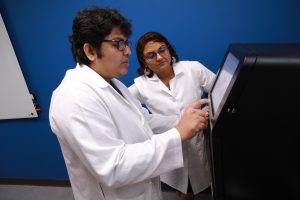
Saroj Chakraborty, a fourth-year Ph.D. student at the University of Toledo, left, and Dr. Bina Joe, Distinguished University Professor and chair of UT’s Department of Physiology and Pharmacology.
Beta hydroxybutyrate is a ketone body produced in the liver from the metabolism of fatty acids. It had not been previously explored as a method for controlling blood pressure, but the UT researchers noted a number of intriguing connections between how the body produces beta hydroxybutyrate and environmental factors known to raise or lower blood pressure.
“As we searched through the literature we saw beta hydroxybutyrate has been observed increasing with exercise or calorie restriction. Both of those activities also reduce blood pressure. The key piece of our discovery is we now know that beta hydroxybutyrate decreases with salt consumption. This is a novel mechanism by which salt is tied to an increase in blood pressure,” said Saroj Chakraborty, a fourth-year PhD student in the UT Department of Physiology and Pharmacology and the paper’s lead author.
To test its hypothesis, the team led by Chakraborty and Joe developed a study in which they fed lab rats a chemical called 1,3-butanediol.
When that supplement reaches the liver, enzymes convert it to beta hydroxybutyrate. From there, it goes to the kidney where it was shown to reduce inflammation commonly associated with hypertension — and significantly decrease blood pressure in the process.
“By fixing the kidney it is indirectly contributing to the lowering of blood pressure. There could be many other organs that it is impacting,” Joe said. “We are studying the heart, blood vessels, brain and other organ systems. But this paper says that this molecule, predominately made in the liver, goes to the kidney, fixes kidney damage and controls your blood pressure.”
Joe noted that controlling function of the liver to regulate blood pressure is a new concept for researchers.
UT has received a provisional patent on the concept. Researchers in Joe’s lab next want to compare the level of beta hydroxybutyrate in hypertensive patients against those without high blood pressure. Further studies also will determine how much 1,3-butanediol is needed to modulate blood pressure and whether it might cause any potential damage to other organs.
Once the team collects that data, the researchers hope to secure funding for a clinical trial.
While lowering blood pressure without hitting the gym might sound appealing to those averse to breaking a sweat, it also could prove beneficial to those who aren’t able to exercise.
“There are certain patients who are not able to exercise for various reasons. This could prove to be a legitimate alternative for those individuals,” Chakraborty said.
Filmmakers to show documentary, lead discussion on racism
Tuesday, October 16th, 2018“Man on Fire,” a documentary about racism, will be screened 6 p.m. Thursday, Oct. 18 in the Thompson Student Union Auditorium.
Filmmakers Joel Fendelman and Dr. James Chase Sanchez will lead a discussion about their work at “The Salt of the Earth: Workshop on Whiteness, White Supremacy and Documentary Filmmaking” 11:30 a.m. Friday, Oct. 19 in Carlson Library Room 1005.
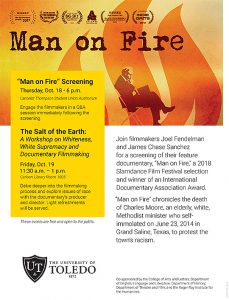 “Man on Fire” focuses on Grand Saline, Texas, which has a history of racism, a history the community refuses to talk about. This shroud of secrecy ended when Charles Moore, an elderly white preacher, self-immolated to protest the town’s racism in 2014, shining a spotlight on the town’s dark past.
“Man on Fire” focuses on Grand Saline, Texas, which has a history of racism, a history the community refuses to talk about. This shroud of secrecy ended when Charles Moore, an elderly white preacher, self-immolated to protest the town’s racism in 2014, shining a spotlight on the town’s dark past.
In the 2017 film, Fendelman and Sanchez examined the protest and question the racism in Grand Saline as it stands today.
“It’s important for people to realize that things like racism and race relations do not exist in a vacuum,” Jennifer Pizio, associate director in the UT Office for Diversity and Inclusion, said. “By taking time to learn about the historical context within which a situation arises, we are better able to grasp the why and how so we can do things differently and, hopefully, better.”
During the Oct. 19 workshop, Fendelman and Sanchez will discuss how whiteness influences everyday conversations about race in Grand Saline. The workshop also will relate this to broader research on the rhetoric of white supremacy.
“The filmmakers will discuss some of the ethical questions they had while making the documentary and how their identities played into it,” Pizio said.
“We are honored to host the documentary screening and the workshop in order to foster these important discussions about racism,” she said.
The free, public events are co-sponsored by the Office of Diversity and Inclusion; the College of Arts and Letters; the Roger Ray Institute for the Humanities; the Department of English, Language and Literature; the Department of History; and the Department of Theatre and Film.
Women & Philanthropy to donate books to 40 TPS second-grade classrooms
Monday, October 15th, 2018Women & Philanthropy and the Judith Herb College of Education at The University of Toledo are donating more than 1,300 new books to Toledo Public Schools.
The books will be distributed to 40 second-grade classrooms at 21 TPS schools.
 Marcy McMahon, the chair of Women & Philanthropy, and Dr. Romules Durant, TPS superintendent, will present the books to representatives from each school 10:30 a.m. Thursday, Oct. 18 at Old Orchard Elementary School, 2402 Cheltenham Rd.
Marcy McMahon, the chair of Women & Philanthropy, and Dr. Romules Durant, TPS superintendent, will present the books to representatives from each school 10:30 a.m. Thursday, Oct. 18 at Old Orchard Elementary School, 2402 Cheltenham Rd.
“Second grade is a critical year for learning to read,” said Dr. Thea Sawicki, chair of the Holiday Project for Women & Philanthropy and professor in the UT Department of Medical Microbiology and Immunology. “We are proud to support every school by providing elementary classroom teachers with additional resources to promote early literacy and allow elementary students to gain greater reading skills.”
This is the second year that fundraising for the Encouraging Early Literacy Holiday Project allowed Women & Philanthropy and the Judith Herb College of Education to donate more than 1,000 new books to TPS second-grade classrooms.
Last year the organizations donated approximately 1,000 books to 33 second-grade classrooms at 19 TPS schools.
This year’s donation covers the remaining classrooms and completes the goal of donating books to start a library in every second-grade classroom at TPS.
“The gift of a book and its potential impact on a young learner’s life cannot be overstated, and should not go unrecognized,” Dr. Raymond Witte, dean of the UT Judith Herb College of Education, said. “It is with great pride that we recognize our association with Women & Philanthropy and their mission to better the lives of children in the Toledo region.”
“The Toledo Public Schools is grateful for the continued support of Women & Philanthropy at The University of Toledo,” Durant said. “Our mission is to create college and career-ready students, and that begins with early literacy. Last year, our students received 1,000 books to be distributed in 33 classrooms, which was incredible in and of itself. This year, we are receiving an even larger donation of 1,300 books for 40 classrooms. We are very thankful for the partnership and also their commitment to helping us deliver on our mission.”
UT scholar’s new book ‘The Oxford Handbook of Disability History’ offers first global chronicle
Monday, October 15th, 2018A pioneering professor of disability studies at The University of Toledo is an editor and contributor to “The Oxford Handbook of Disability History.”
Dr. Kim Nielsen, who helped launch the first undergraduate degree of its kind in disability studies in the country at UT, is one of three editors of the book published by Oxford University Press and one of 30 experts to write a chapter.
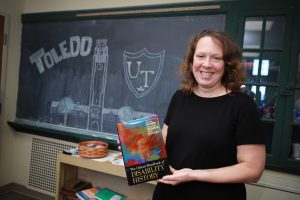
Dr. Kim Nielsen
“Disability has a generally unacknowledged or even enthusiastically denied universality,” Nielsen said. “The book is the first volume to represent the global scale of this history, from ancient Greece to British West Africa and post-World War II Hungary and contemporary Japan.”
The cover of the book is designed by a group of artists who work together at Shared Lives Studio in downtown Toledo.
“We wanted meaningful, quality art done by a person or persons with disabilities, and we found it,” Nielsen said. “Their work is beautiful.”
Nielsen’s co-editor Dr. Michael Rembis, associate professor in the Department of History and director of the Center for Disability Studies at the University at Buffalo, will host a public lecture at UT titled “A Fact was No Less a Fact Because it was Told by a Crazy Person” 4 p.m. Wednesday, Oct. 17 in Carlson Library Room 1005.
“Dr. Rembis is a skilled historian and storyteller whose work can help us better understand today’s mental health practices and helps us remember that people considered mentally ill also live lives with family, labor, community institutions and day-to-day interactions,” Nielsen said. “This scholarship should be of interest to all interested in public health policies, disability, history, psychology and social change.”
In the introduction to the new book, the editors wrote, “By its very nature, an Oxford Handbook offers legitimacy to disability history, an indication of the field’s growing import.”
Nielsen’s book chapter is titled “The Perils and Promises of Disability Biography.”
“Telling the life story of someone whose life included disability, unpacking the relationship between that individual life and its larger historical context, and analyzing the questions and insights raised by that life have much to offer scholars and readers,” Nielsen wrote.
“A disability analysis does not simply mean discerning whether or not historical subjects have a disability, just as a gender or racial analysis does not simply mean discerning the race or sex of historical subjects. A disability approach analyzes the role of ableism – built structures and social systems that favor the nondisabled – in shaping relationships, systems of power, ideals, disparagements, and the multiple ways of being in the world.”
Nielsen fights back against the common narrative of disability in the Western world that an individual overcomes or “triumphs over the calamity of disability.”
She uses President Franklin Roosevelt as an example showing that his life reveals the embedded nature of disability.
“From the time he was first affected by polio as a young adult to his death while in his fourth term as the U.S. president, the wealthy son of a prestigious New York family was aided by an extensive network of individuals willing to help him pass as nondisabled,” Nielsen wrote. “The FDR that most of us know and admire today was made possible by an intimate network of support; an American public that variably denied, ignored or was ignorant of his disability; and historians who followed that path.”
Nielsen also discusses the use of primary sources, the opportunities to analyze previously unconsidered sources, and reconsidering the imbalanced power dynamics used to create and archive historical sources.
“For example, many, if not all, of the photographs of Millie and Christine McKoy, conjoined twins born into slavery in 1851, made under the guise of science, were sexually exploitive, coerced and sensationalistic,” Nielsen wrote. “Many people with disabilities live and have lived in times and spaces where they have no recognized right or access to privacy.”
As a historian who is not disabled, Nielsen opens up about the importance of visiting places central to individuals who were overlooked or hidden away from society, such as her visit to the grave of the subject of her current biographical project, Dr. Anna Ott, a white female physician who died in 1893 after being determined legally incompetent and institutionalized for 20 years in a state insane asylum as a patient of one of her former male colleagues.
Of the 771 people buried at the “nearly unmarked cemetery” over a nearly 100-year period, Nielsen said, “Only eight of the dead had the privilege of grave markers. The rest lay unnamed and largely unclaimed. The disregard with which they had been treated in death revealed much about their lives.”
Nielsen also said that disability biography can be about nondisabled subjects, such as Frances Perkins, who “served as Secretary of Labor in the Franklin Roosevelt administration, while simultaneously mothering a daughter, providing exclusive financial support for her household, and caring for/managing her frequently institutionalized husband.”
“Perkins was not disabled, but disability permeated her life,” Nielsen wrote.
Nielson’s most recent book, “A Disability History of the United States,” was published by Beacon Press in 2012.
National prison reform researcher, author to discuss mass incarceration epidemic
Friday, October 12th, 2018A national expert on prison reform is visiting The University of Toledo next week to give two free, public talks.
Dr. John F. Pfaff, professor of law at Fordham University, is the author of the 2017 book, “Locked In: The True Causes of Mass Incarceration and How to Achieve Real Reform.”
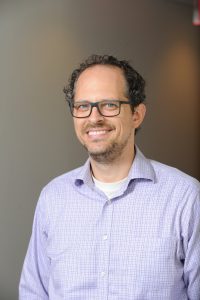
Dr. John F. Pfaff, professor of law at Fordham University
“Dr. Pfaff’s research shows that only by reducing the power and discretion of public prosecutors and reducing the length of prison sentences for violent offenses will we see any significant reduction in prison populations,” said Dr. Renee Heberle, UT professor of political science and co-director of the UT Law and Social Thought Program.
On Tuesday, Oct. 16, Pfaff will give a talk titled “Moving Past the Standard Story: Rethinking the Causes of Mass Incarceration” at 7 p.m. in the Driscoll Alumni Center Auditorium.
And on Wednesday, Oct. 17, Pfaff will discuss “Sentencing Violent Offenders: Rethinking How We Confront Mass Incarceration” at 11:50 a.m. in Law Center Room 1002.
Pfaff spent 15 years researching imprisonment data to try to understand the 40-year boom in U.S. incarceration rates.
“The statistics are as simple as they are shocking: The United States is home to 5 percent of the world’s population but 25 percent of its prisoners,” he wrote in the introduction to “Locked In.”
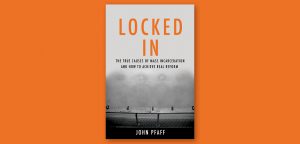 “Mass incarceration is one of the biggest social problems the United States faces today; our sprawling prison system imposes staggering economic, social, political and racial costs,” he wrote.
“Mass incarceration is one of the biggest social problems the United States faces today; our sprawling prison system imposes staggering economic, social, political and racial costs,” he wrote.
“Professor Pfaff will discuss his research and recent book, which illuminates the previously underappreciated roles prosecutorial discretion and sentencing policy have played in driving up prison populations,” Heberle said.
“While it is common to focus on recidivism rates, crime rates and non-violent drug offenders as causes for mass incarceration, Dr. Pfaff’s careful empirical approach makes very clear that only limiting prosecutorial power and significantly reducing the length of sentences will ultimately render mass incarceration obsolete,” she said.
The free, public events are sponsored by the UT College of Law and the UT Law and Social Thought Program.
The University of Toledo, Toledo Museum of Art partner to advance visual literacy
Friday, October 12th, 2018The University of Toledo and Toledo Museum of Art announced today a strengthened partnership that will advance visual literacy education.
The new initiative will provide opportunities for UT students across all majors to master the ability to “speak visual” through targeted curriculum modules incorporated into their existing course offerings.
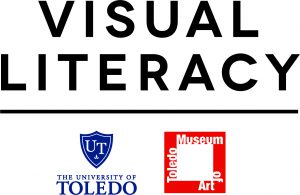
The Association of College & Research Libraries (ACRL) defines visual literacy as a set of abilities that enables an individual to effectively find, interpret, evaluate, use and create images and visual media. Visual literacy is a skill that is critical to effective communication, creativity and design thinking.
“This collaboration will provide our students engaging lessons within their disciplines that will give them a step up when it comes to better explaining their complex scientific data graphically or connecting in a new way with the community to solve important social issues,” UT President Sharon L. Gaber said. “Visual literacy is an important skill for our students who are the future leaders of our community and our world. We are excited to strengthen our partnership with the museum to advance this discipline.”
“Learning to read, understand and write visual language is an ability that helps all aspects of life,” TMA Director Brian Kennedy said. “The visually literate person uses sensory skills for critical thinking, by better interpreting the world around us, thereby advancing opportunity for a more productive and engaged life.”
This collaboration leverages the strengths of TMA’s Center of Visual Expertise (COVE) and the Museum’s experience teaching visual literacy to young K-12 students, as well as professionals in the industrial and manufacturing fields, in combination with the strengths of UT’s Center for the Visual Arts in art education, Jesup Scott Honors College in interdisciplinary learning and UT Libraries in supporting information literacy.
The initiative began with a pilot Honors seminar course co-taught by UT and museum educators and an elective for medical students called “Art and Medicine: Using Visual Literacy to Improve Diagnostic Skills.”
The curriculum module options will be expanded to be available to all courses on campus. The goal is to have the visual literacy modules adopted into at least 20 additional courses in the spring semester.
The effort is led by Dr. Heidi Appel, dean of the Jesup Scott Honors College at UT, and Mike Deetsch, Director of Education and Engagement at TMA, and involves a team of approximately 20 faculty and staff from both institutions who are contributing their time to this partnership.
The visual literacy initiative was made possible, in part, with financial support from Judith Herb, a generous longtime supporter of both institutions.
UT harmful algal bloom expert to discuss health of Lake Erie Oct. 18
Thursday, October 11th, 2018The University of Toledo Lake Erie Center is hosting a free, public event next week about water quality monitoring, the search for solutions to harmful algal blooms and how the overall health of Lake Erie has been changing.
Dr. Thomas Bridgeman, UT professor of ecology and director of the UT Lake Erie Center, will give a talk titled “Lake Erie: Still Fishable, Swimmable and Drinkable (Mostly)” 7 p.m. Thursday, Oct. 18 at the Maumee Bay State Park Lodge, 1750 State Park Road in Oregon.
 “Blanket statements about Lake Erie’s problems don’t do it justice,” Bridgeman said. “We need to be smart about when, where and how we use the lake, but most of the time the lake is in great shape and people can still interact with it in fun and healthy ways.”
“Blanket statements about Lake Erie’s problems don’t do it justice,” Bridgeman said. “We need to be smart about when, where and how we use the lake, but most of the time the lake is in great shape and people can still interact with it in fun and healthy ways.”
Bridgeman has monitored, tracked and studied algae in the Great Lakes for nearly two decades. He helps sound the early warning for water treatment plant operators throughout algal bloom season, which recently ended for the year.
Bridgeman also connects with legislative policy makers to raise awareness about his research exploring ways to protect the lake and ensure communities continue to have access to safe drinking water.
“I’ll be talking about how much more we know now than we used to and how we are getting better at tracking lake water conditions and predicting potential problems so that people can plan ahead,” Bridgeman said.
The Lake Erie Center is UT’s freshwater research and science education campus focused on finding solutions to water quality issues that face the Great Lakes, including harmful algal blooms, invasive species and pollutants.
Water quality is a major research focus at UT. With more than $14 million in active grants underway, researchers are looking for pathways to restore our greatest natural resource for future generations.
Bridgeman’s talk is part of the Lake Erie Center’s Public Lecture Series.
A shuttle will be available to transport passengers from UT’s Main Campus to the Maumee Bay State Park Lodge and back. The shuttle departs at 6:15 p.m. from the south side of Bowman-Oddy Laboratories, 3100 West Towerview Blvd. Passengers must reserve a spot by Tuesday, Oct. 16. Email lakeeriecenter@utoledo.edu or call 419.530.8360 to make a reservation for the shuttle.

